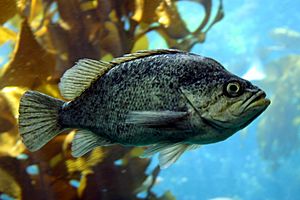Kelp rockfish facts for kids
Quick facts for kids Kelp rockfish |
|
|---|---|
 |
|
| Scientific classification | |
| Kingdom: | |
| Phylum: | |
| Class: | |
| Order: | |
| Family: |
Sebastidae
|
| Genus: |
Sebastes
|
| Species: |
S. atrovirens
|
| Binomial name | |
| Sebastes atrovirens (Jordan and Gilbert, 1880)
|
|
The kelp rockfish (Sebastes atrovirens) is a type of fish that lives in the Pacific Ocean. You can find it along the coast of California in the United States and Baja California in Mexico. It is part of the rockfish family.
Contents
About the Kelp Rockfish
This fish can grow to about 42 centimeters (about 16.5 inches) long. It can live for a long time, usually between 15 and 20 years, and sometimes even up to 25 years!
Kelp rockfish can be many different colors. They might be tan, brown, green, reddish, blackish, or even whitish. Some have brown spots. Their snout looks like it is turned slightly upwards.
Like some other rockfish, the kelp rockfish can make sounds. It produces a low, pulsing noise to communicate with other fish.
Where They Live
This marine fish lives in the ocean from Sonoma County, California, all the way south to central Baja California. The climate in these areas is subtropical, which means it's usually warm.
Kelp rockfish live in coastal waters. They can be found as deep as 42 meters (about 138 feet), but they usually stay in shallower water, often less than 12 meters (about 39 feet) deep. Their favorite homes are kelp beds and rocky areas on the seabed.
They often live near other types of rockfish. However, kelp rockfish prefer to stay very close to the kelp itself. During the day, they often rest on the long blades of kelp, sometimes even upside down! The main type of kelp they live in is called Macrocystis pyrifera, also known as giant kelp. Other types of brown algae in their habitat include Pterygophora californica and Cystoseira osmundacea. They can also be found living around man-made structures, like oil rigs.
What They Eat
The kelp rockfish mostly eats crustaceans. These are creatures with hard shells, like the isopod Pentidotea resecata. They also eat cephalopods (like small squid) and snails. Sometimes, they will even eat young blue rockfish or plainfin midshipmen.
Kelp rockfish do most of their hunting at night. When they are very young, called larvae, they are fed tiny organisms like rotifers and copepods if they are raised in captivity. As they grow, they start eating brine shrimp. Adult kelp rockfish in captivity can eat chopped squid and live fish like the night smelt.
Reproduction and Life Cycle
Spawning (when fish release eggs and sperm) for kelp rockfish starts in February in the northern parts of their range. Farther south, it begins in March.
A female kelp rockfish can mate with several males. She can also store sperm, which means her babies might have different fathers. Like other fish in its family, this species is viviparous. This means the mother gives birth to live young, instead of laying eggs.
The female releases all her babies at once, but only during the night. When they are born, the larvae are very tiny, only about 4 to 5 millimeters long. They have a small bit of yolk or oil on their belly, which they absorb for food within a few days. They quickly grow small spines on their heads. At birth, they already have some color, and they develop more as they grow bigger.
Role as Prey
The kelp rockfish is an important food source for many other animals in the ocean.
- Larvae: Very young kelp rockfish are eaten by tiny creatures like siphonophores and chaetognaths.
- Juveniles: Young kelp rockfish become food for other fish, such as lingcod, cabezon, and salmon. Many birds, pinnipeds (like seals), and porpoises also hunt them.
- Adults: Full-grown kelp rockfish are prey for larger animals like sharks, dolphins, and seals.
People also catch kelp rockfish. They are taken by spearfishing and angling (fishing with a rod and line).

